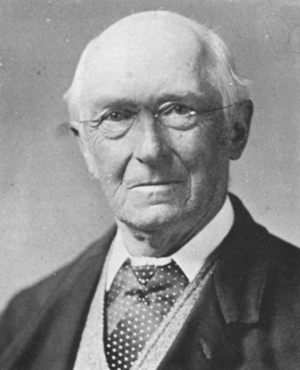Albert Günther facts for kids
Quick facts for kids
Albert Günther
|
|
|---|---|
 |
|
| Born |
Albert Charles Lewis Gotthilf Günther
3 October 1830 |
| Died | 1 February 1914 (aged 83) Kew Gardens, Richmond-on-Thames, England
|
| Citizenship | United Kingdom |
| Education | University of Tübingen |
| Known for | Description of more than 340 reptile species, Catalogue of Fishes |
| Awards | Linnean Medal (1904) |
| Scientific career | |
| Fields | Zoologist |
| Institutions | British Museum |
| Influences | John Edward Gray, Richard Owen |
| Author abbrev. (zoology) | Günther |
Albert Günther (born October 3, 1830 – died February 1, 1914) was a famous German-born British zoologist. A zoologist is a scientist who studies animals. Günther was especially good at studying fish (an ichthyologist) and reptiles and amphibians (a herpetologist). He is known for describing over 340 different kinds of reptiles!
Contents
Early Life and Amazing Discoveries
Albert Günther was born in a town called Esslingen in Germany. His family hoped he would become a minister in the church. But Albert was more interested in science and medicine. So, in 1852, he started studying these subjects at the University of Tübingen.
After finishing his medical degree in 1858, Günther visited England. There, he met two important scientists at the British Museum: John Edward Gray and Professor Richard Owen. They were very impressed with him. In 1857, they offered him a job at the British Museum. His first big task was to sort and identify 2,000 snake specimens!
Later, in 1875, Günther became the Keeper of Zoology at the Natural History Museum. He held this important job until 1895.
One of his biggest achievements was writing an eight-volume book called Catalogue of Fishes. This huge work was published between 1859 and 1870. He also spent a lot of time studying the museum's collection of reptiles and amphibians.
In 1864, he helped start a scientific publication called Record of Zoological Literature. He was its editor for six years. He also worked as an editor for the Annals and Magazine of Natural History for over 30 years.
Günther made a very important discovery about the tuatara. This reptile looks like a lizard but is actually quite different. Günther was the first to show that the tuatara was not a lizard at all. Instead, it was the only living member of a completely new group of reptiles. He named this group Rhynchocephalia. Later, scientists found more proof that Günther was right. The tuatara is now known as the only living relative of a very old group of reptiles. This group shared a common ancestor with lizards and snakes over 240 million years ago!
Working with Important Societies
Albert Günther was a very respected scientist. In 1867, he was chosen to be a fellow of the Royal Society. This is a very high honor for scientists in the UK. He also served as the vice-president of the Royal Society from 1875 to 1876.
He was involved with the Zoological Society of London for almost 40 years. He was also elected a fellow of the Linnaean Society in 1877. He even became its president from 1896 to 1900.
In 1874, Albert Günther became a British citizen. He passed away at Kew Gardens on February 1, 1914.
His Family Life
Albert Günther was the son of Friedrich Gotthilf Günther and Eleonora Louise Nagel.
He was married twice. His first wife was Roberta Mitchell McIntosh, and they had one son, Robert William Theodore Günther. Robert later became a historian. After Roberta passed away, Albert married Theodora Dowrish Drake. They had two children, a son named Frederic and a daughter named Theodora.
His Lasting Legacy
Albert Günther's work was so important that many animal species are named after him. This is a way to honor his contributions to science. When you see "guentheri" in a scientific name, it's often named after him!
Here are some of the reptiles named after Albert Günther:
- Aparallactus guentheri – an African venomous snake
- Atractus guentheri – a Brazilian snake
- Aspidura guentheri – a Sri Lankan snake
- Chalcides guentheri – a Near Eastern lizard
- Christinus guentheri – an Australian lizard
- Coluber gracilis – an Indian snake, known as Günther's racer
- Draco guentheri – a Philippine lizard
- Elapsoidea guentheri – an African venomous snake
- Erythrolamprus guentheri – a South American snake
- Euspondylus guentheri – a South American lizard
- Holaspis guentheri – an African lizard
- Lycodryas guentheri – a Malagasy snake
- Riopa guentheri – an Indian lizard
- Monopeltis guentheri – an African amphisbaenian
- Perochirus guentheri – a South Pacific lizard
- Phelsuma guentheri – a Mauritian lizard
- Plectrurus guentheri – an Indian snake
- Proctoporus guentheri – a South American lizard
- Ramphotyphlops guentheri – an Australian snake
- Ristella guentheri – an Indian lizard
- Scelotes guentheri – an extinct South African lizard
- Sphenodon guntheri – a New Zealand rhynchocephalian
- Stegonotus guentheri – a Papua New Guinean snake
- Stenocercus guentheri – a South American lizard
- Trachischium guentheri – an Asian snake
- Uroplatus guentheri – a Malagasy lizard
- Urotheca guentheri – a Central American snake
- Xenodon guentheri – a Brazilian snake
And one fish:
- The carnivorous catfish Astroblepus guentheri
See Also
 In Spanish: Albert Günther para niños
In Spanish: Albert Günther para niños
- Robert Günther, Albert Günther's son and a historian of science
- Category:Taxa named by Albert Günther

